Photo report from the construction of a 570 megapixel camera
The world's largest device to search for dark matter will soon be ready to go. The construction of a four-ton Dark Energy Camera worth $ 35 million will be completed in a month at the Fermilab laboratory in Illinois. There, they are testing it now, having installed it into the mount from the telescope (the mount assembly is on video). And in full force, the camera will work after installation on the telescope of Victor Blanco in the mountains of Chile, in October 2012.
Participants in this project are going to measure the speed of 300 million galaxies in the southern hemisphere of the starry sky to test the theory of the existence of dark matter.
The Dark Energy Survey project and this 570-megapixel camera have already been discussed at Habré , and now we offer to see a photo report directly from the construction site.
')
The camera has been built since 2008 by 120 astronomers, engineers and physicists.
The imager capture unit contains 74 individual sensors with a total resolution of 570 MP.
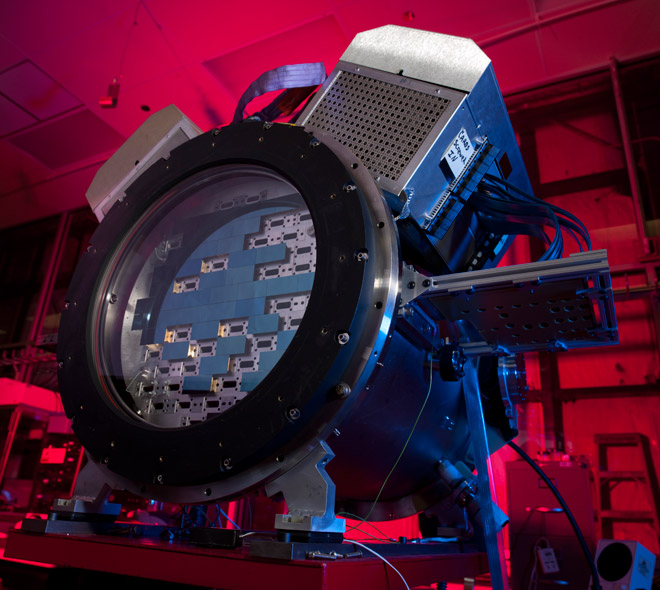
Today, there is only one higher resolution camera in the world: the Pan-STARRS telescope at 1400 MP, which is looking for dangerous asteroids approaching the Earth. But Dark Energy Camera is unmatched in weight. The image capturing unit alone weighs about 910 kg.
Both “competitors” can easily confound the planned for construction of the Large Synoptic Survey Telescope by 3200 MP, which will also be looking for traces (effects) of dark matter. The only problem is that there is no money for its construction.
In the photo, the technician checks the matrix of 74 CCD sensors. Twelve of these sensors have a lower resolution (about 53 MP in total), they are necessary for pointing and focusing the telescope. The remaining 62 sensors (519 MP) directly take pictures of galaxies.
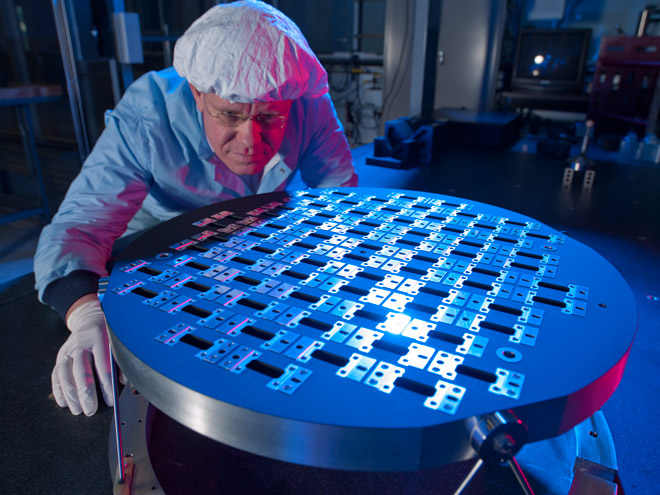
All CCD sensors are not serial, and are made on special order in accordance with the required characteristics - so that they are as sensitive as possible in the infrared range (in which it is supposed to remove the displacement of distant galaxies).
Approximately this picture gives all the sensors together.
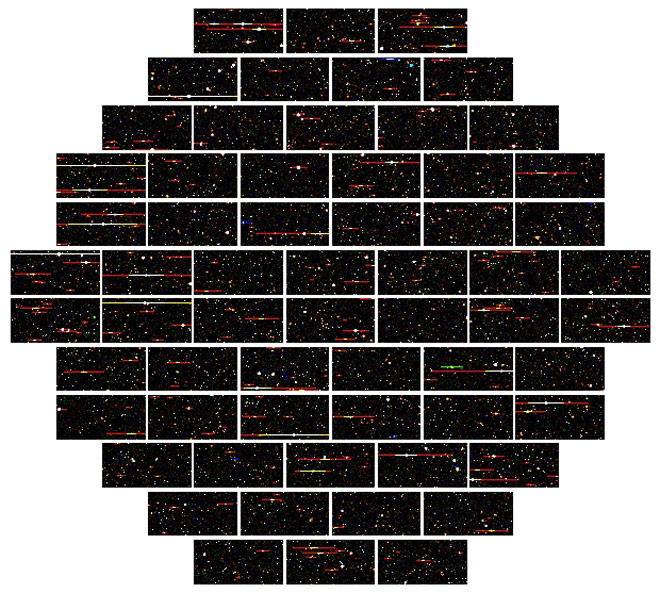
Each night, the camera will take about 400 full-size photos, each with a capacity of 1 GB. From the substation in Chile, they will immediately be sent for processing and analysis to the National Center for Supercomputer Applications in Illinois.
The heavy parts of the camera will not hang on the telescope itself. For them, the engineers built a separate 3.4-meter "case." In the photo below you can see the unit with sensors (left), the main optical focusing system (right) and two of the six pneumatic tubes for camera guidance.

The Victor Blanco telescope is located in one of the most advanced observatories in the southern hemisphere - the Cerro Tololo Inter-American Observatory in Chile. The scale diagram of the telescope depicts two people (red circle) and the installation location of the Dark Energy Camera (green circle).
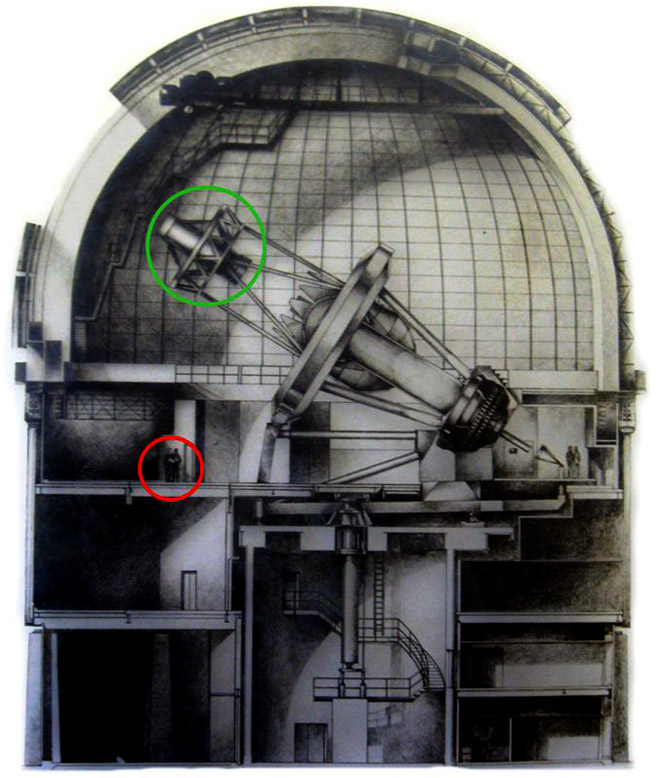
The details of the world's heaviest camera inspire respect. Before contact with the sensors, the light passes through four 61 cm wide filters. They filter the range of the passing waves, so that nothing extra can fall on the sensors. In the infrared range, sensors will, in fact, make a black and white picture. Then, scientists-artists realistically paint it in different colors using scientific methods (they specifically calculate which color is most logical for waves of a certain length).

The following photo shows perhaps the largest in the world and the diaphragm and shutter curtains. Two steel blinds are hidden around the perimeter: they start moving every time the camera takes a picture. The curtains move not too fast, because for shooting stars you need a long exposure of 1-2 minutes.
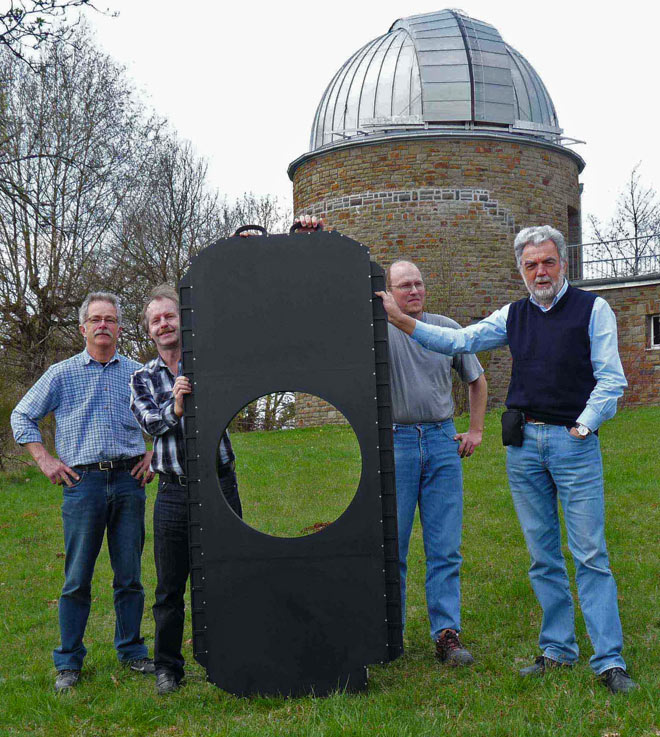
And here is a homemade lens.
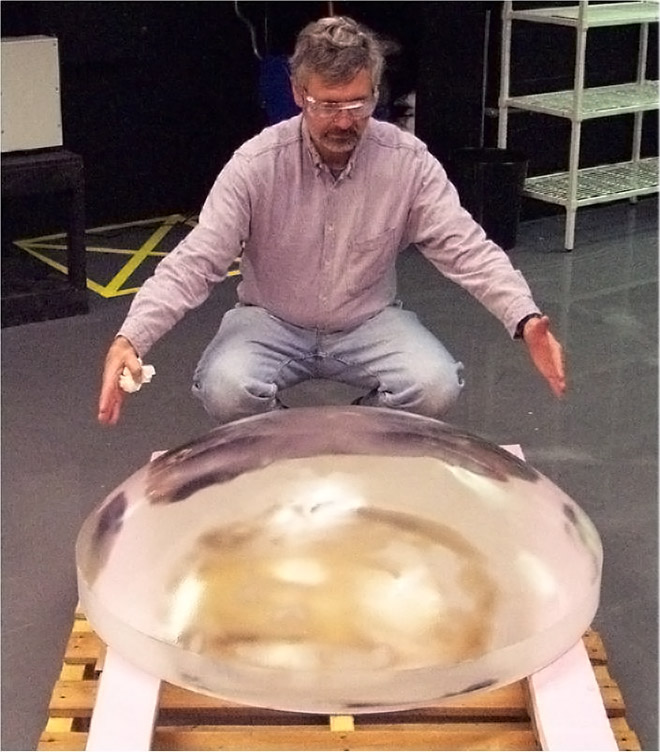
The optical system of the camera consists of five lenses that must focus the image from the 4-meter telescope mirror. After installation, the optics will be able to scan the sky, 20 times larger in area than the moon takes.
The following illustration shows the entire assembly. It will look like this after the end of the assembly this year.
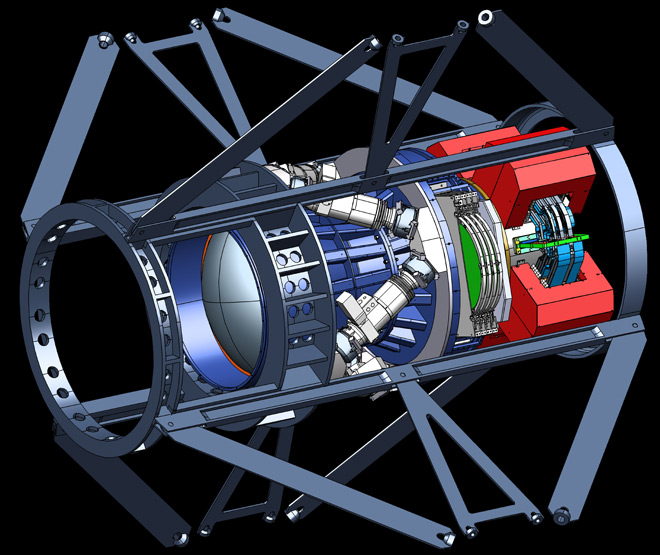
Testing cameras are hoping to finish in February 2011.
The image capturing unit will be sent to Chile on a separate aircraft in June of 2011, all the rest will be shipped through New York by ship in cargo containers. Passing through the Panama Canal and unloading on the coast of Chile, the details of the cell will be transported by trucks to the mountains where the observatory is located (approximately 360 km north of Santiago).
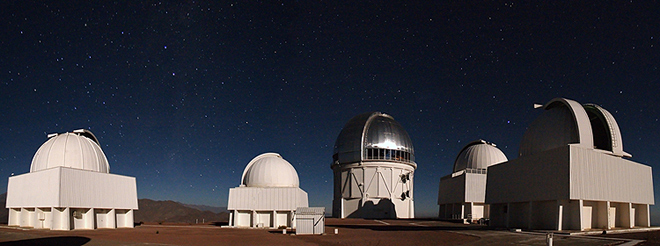
The telescope occupies a central place in the observatory (a brilliant building in the center). The camera will take pictures of 525 nights over five years. Ideally, convincing evidence of whether dark matter exists or not and whether Einstein’s general theory of relativity is suitable for describing gravity on the macroscale of the Universe will be obtained.
Participants in this project are going to measure the speed of 300 million galaxies in the southern hemisphere of the starry sky to test the theory of the existence of dark matter.
The Dark Energy Survey project and this 570-megapixel camera have already been discussed at Habré , and now we offer to see a photo report directly from the construction site.
')
The camera has been built since 2008 by 120 astronomers, engineers and physicists.
The imager capture unit contains 74 individual sensors with a total resolution of 570 MP.

Today, there is only one higher resolution camera in the world: the Pan-STARRS telescope at 1400 MP, which is looking for dangerous asteroids approaching the Earth. But Dark Energy Camera is unmatched in weight. The image capturing unit alone weighs about 910 kg.
Both “competitors” can easily confound the planned for construction of the Large Synoptic Survey Telescope by 3200 MP, which will also be looking for traces (effects) of dark matter. The only problem is that there is no money for its construction.
In the photo, the technician checks the matrix of 74 CCD sensors. Twelve of these sensors have a lower resolution (about 53 MP in total), they are necessary for pointing and focusing the telescope. The remaining 62 sensors (519 MP) directly take pictures of galaxies.

All CCD sensors are not serial, and are made on special order in accordance with the required characteristics - so that they are as sensitive as possible in the infrared range (in which it is supposed to remove the displacement of distant galaxies).
Approximately this picture gives all the sensors together.

Each night, the camera will take about 400 full-size photos, each with a capacity of 1 GB. From the substation in Chile, they will immediately be sent for processing and analysis to the National Center for Supercomputer Applications in Illinois.
The heavy parts of the camera will not hang on the telescope itself. For them, the engineers built a separate 3.4-meter "case." In the photo below you can see the unit with sensors (left), the main optical focusing system (right) and two of the six pneumatic tubes for camera guidance.

The Victor Blanco telescope is located in one of the most advanced observatories in the southern hemisphere - the Cerro Tololo Inter-American Observatory in Chile. The scale diagram of the telescope depicts two people (red circle) and the installation location of the Dark Energy Camera (green circle).

The details of the world's heaviest camera inspire respect. Before contact with the sensors, the light passes through four 61 cm wide filters. They filter the range of the passing waves, so that nothing extra can fall on the sensors. In the infrared range, sensors will, in fact, make a black and white picture. Then, scientists-artists realistically paint it in different colors using scientific methods (they specifically calculate which color is most logical for waves of a certain length).

The following photo shows perhaps the largest in the world and the diaphragm and shutter curtains. Two steel blinds are hidden around the perimeter: they start moving every time the camera takes a picture. The curtains move not too fast, because for shooting stars you need a long exposure of 1-2 minutes.

And here is a homemade lens.

The optical system of the camera consists of five lenses that must focus the image from the 4-meter telescope mirror. After installation, the optics will be able to scan the sky, 20 times larger in area than the moon takes.
The following illustration shows the entire assembly. It will look like this after the end of the assembly this year.

Testing cameras are hoping to finish in February 2011.
The image capturing unit will be sent to Chile on a separate aircraft in June of 2011, all the rest will be shipped through New York by ship in cargo containers. Passing through the Panama Canal and unloading on the coast of Chile, the details of the cell will be transported by trucks to the mountains where the observatory is located (approximately 360 km north of Santiago).

The telescope occupies a central place in the observatory (a brilliant building in the center). The camera will take pictures of 525 nights over five years. Ideally, convincing evidence of whether dark matter exists or not and whether Einstein’s general theory of relativity is suitable for describing gravity on the macroscale of the Universe will be obtained.
Source: https://habr.com/ru/post/108395/
All Articles